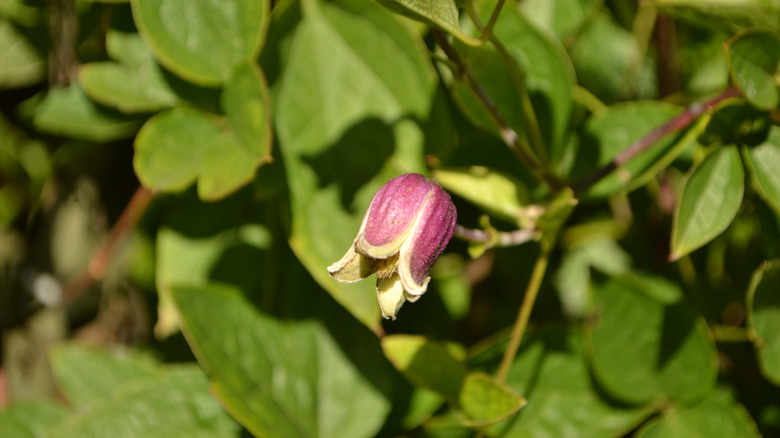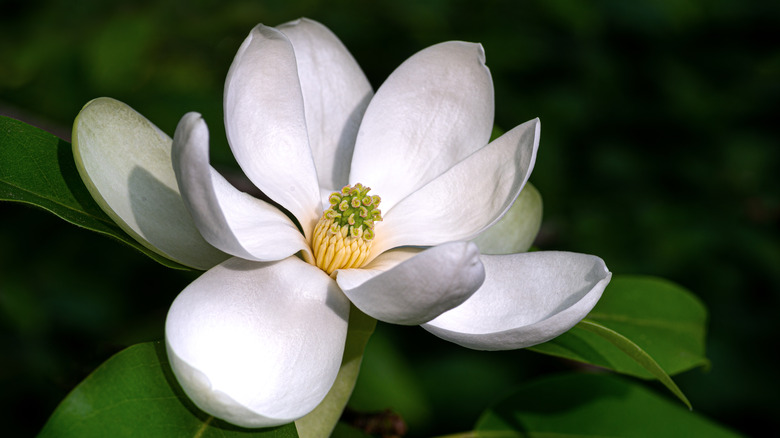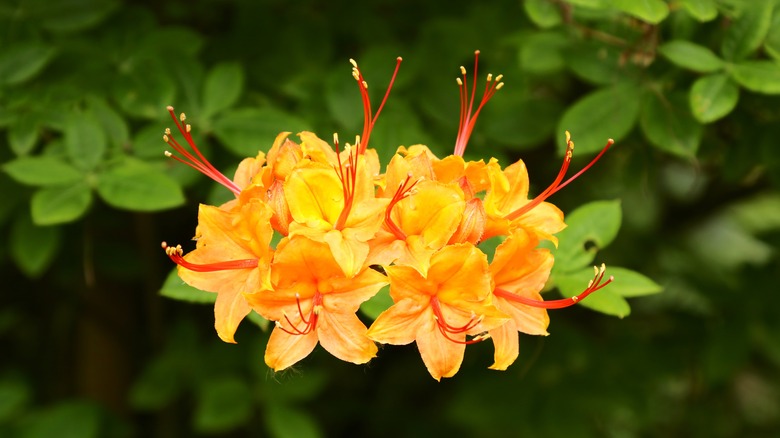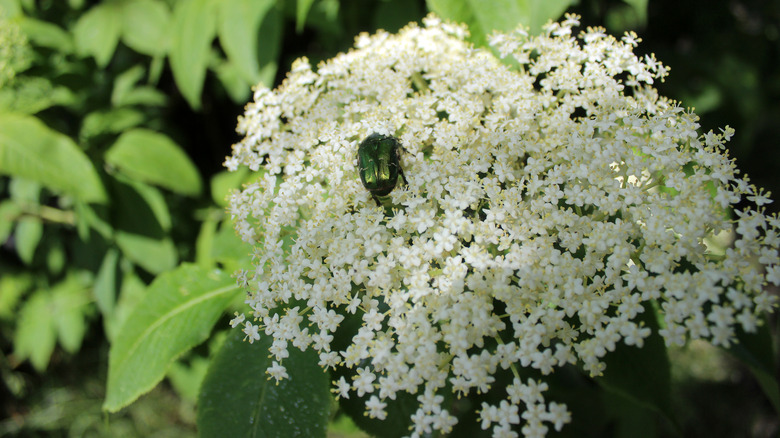15 Endangered Plants Native To The US You Can Grow In Your Garden
Native gardens are all the rage as communities around the world are looking to reverse climate change, save dying species of local insects or animals, and revive endangered plants native to their region. The United States is home to a range of plant species that are quickly disappearing due to spreading wildfires, urbanization, disease, and aggressively-growing invasive species of non-native plants. North Shore Land Alliance warns that our planet is experiencing high rates of plant extinction at the hands of humans. In fact, this widespread extinction is taking place about 500 times faster than scientists would expect; nearly 600 plant species have died off in just 250 years.
Thankfully, there is something we can do about this. By researching plants local to our areas, we can create gardens full of native, threatened plant species. In every U.S. state, there are dozens of trees, flowers, shrubs, and herbaceous plants that need our help. Not only will this kind of gardening aid in the revival of local plants, it will attract native insects and wildlife that eat from or live in the foliage, flowers, and fruit. If you're ready to help these plants, check out this collection of endangered plants native to the U.S. that you can start growing today.
1. Bunched arrowhead
Bunched arrowhead (Sagittaria fasciculata) is an herbaceous perennial native to the U.S. A member of the Alismataceae family, this plant features lance-shaped leaves and small white and yellow flowers that appear in the spring and summer. According to North Carolina State Extension, the bunched arrowhead plant is an endangered species usually found growing in the Carolinas in deciduous forests or other sloping landscapes.
Bloom Season: Spring and summer
USDA Growing Zone: 6
Growing Conditions: Partial sun to full shade
Soil Type: Wet to moist loam or standing water
Size: 3 to 12 inches tall and wide
2. Leafy prairie clover
The leafy prairie clover (Dalea foliosa) is a rare perennial species that is grown in medium or dry soil prairies in temperate regions of the U.S. You can identify this long-blooming species by its purple spikes of flowers that will bring bees into your yard and its abundance of small ovate leaves. Prairie Moon Nursery mentions that the clover is nearly extinct today, but it can still be grown in home gardens.
Bloom Season: Summer to fall
USDA Growing Zone: 4 to 7
Growing Conditions: Full sun to partial shade
Soil Type: Well-draining
Size: 2 feet tall
3. Antioch dunes evening primrose
Antioch dunes evening primrose (Oenothera deltoides spp. howellii), explains Annie's Annuals and Perennials, is one of the rarest primrose species in the world. Its flowers are small, white, and scented, typically opening to a diameter of 1 inch. Though the plant is uncommon, it's still easily grown in the garden provided it receives plenty of sunlight, water, and attention.
Bloom Season: Summer
USDA Growing Zone: 9 to 10
Growing Conditions: Full sun
Soil Type: Well-draining
Size: 12 inches tall and 18 inches wide
4. Yellow coneflower
The yellow coneflower (Echinacea paradoxa) is related to the popular purple coneflower commonly grown throughout the year in gardens everywhere. However, this species of coneflower takes a lot of patience to grow. After being planted in your garden, it can take up to five years before it produces a full set of flowers, per the University of Wisconsin-Madison.
Bloom Season: Early summer
USDA Growing Zone: 3 to 9
Growing Conditions: Full sun
Soil Type: Humus-rich and well-draining
Size: 18 to 36 inches tall
5. Cumberland rosemary
Cumberland rosemary (Conradina verticillata) is a broadleaf evergreen plant native to the Cumberland Plateau located in eastern Kentucky and Tennessee. According to the Missouri Botanical Garden, it is federally listed as threatened by the U.S. Fish and Wildlife Service. The plant is most often identified by its pink-purple flowers that bloom in the spring as well as its square-stemmed branches with thin, aromatic leaves.
Bloom Season: Spring and summer
USDA Growing Zone: 6 to 8
Growing Conditions: Full sun
Soil Type: Well-draining and sandy
Size: 1 to 2 feet tall and wide
6. Eastern prickly pear cactus
The eastern prickly pear cactus (Opuntia humifusa) is known for its paddle-like leaves covered in sharp spikes and its bright yellow flowers. This sun-loving species grows naturally in the eastern part of the U.S. in areas where it stays dry. Even in colder regions, this cactus species can survive. As noted by Prairie Moon Nursery, the prickly pear cactus will slowly spread into a low mat loved by pollinators.
Bloom Season: Summer
USDA Growing Zone: 4 to 9
Growing Conditions: Full sun
Soil Type: Sandy and well-draining
Size: 6 inches tall
7. Vasevine
Vasevine plants (Clematis viorna), which are also sometimes called leatherflowers, are a species of twining vines native to the north-central and eastern parts of America. The plant is loved by many gardeners who enjoy its unique downward arching flowers. To properly care for a vasevine plant you must plant it in well-draining soil where it won't be subject to any harsh direct sunlight, advises North Carolina State Extension.
Bloom Season: Spring and summer
USDA Growing Zone: 4 to 9
Growing Conditions: Dappled sunlight to partial shade
Soil Type: Well-draining
Size: 8 to 12 feet long
8. Sea oats
Sea oats (Uniola paniculata) were once prolific plants that claimed much of the eastern coastline of the U.S. Today, it is much less abundant and even considered endangered. According to the University of Florida, sea oats play an important role in stabilizing dunes and feeding native wildlife. East coast citizens are encouraged to plant sea oats to reverse the threats they are facing.
Bloom Season: Spring and summer
USDA Growing Zone: 7 to 11
Growing Conditions: Full sun
Soil Type: Well-drained and sandy
Size: 5 to 8 feet tall
9. Barbara's buttons
Barbara's buttons (Marshallia grandiflora) is an herbaceous plant species in the Asteraceae family that shows off small, pink flowers in the summer. Native to the northeast, this perennial prefers direct sunlight, well-draining soil, and frequent watering. Per Missouri Botanical Garden, Barbara's buttons will grow taller than a foot when cared for properly.
Bloom Season: Summer
USDA Growing Zone: 5 to 9
Growing Conditions: Full sun to partial shade
Soil Type: Moist, humusy, and well-draining
Size: 12 to 18 inches tall and 9 to 12 inches wide
10. Sweetbay magnolia tree
Sweetbay magnolia trees (Magnolia virginiana) are well-known for their large flowers, glossy leaves, and lemon scent during their bloom season, says the Arbor Day Foundation. These trees are recommended for people living in temperate parts of the U.S. as a specimen or patio tree depending on the size of your yard.
Bloom Season: Spring and summer
USDA Growing Zone: 5 to 9
Growing Conditions: Full sun to partial shade
Soil Type: Acidic, moist, rich, and well-draining
Size: 10 to 20 feet tall and wide
11. Flame azalea tree
With a wide growth habit and bright flowers that last for months, flame azalea trees (Rhododendron calendulaceum) are extremely valuable in the garden and among the best bushes to plant in front of your house. Per North Carolina State Extension, flame azaleas can be difficult to grow because they are susceptible to many different diseases such as canker, powdery mildew, leaf spot, and crown rot.
Bloom Season: Spring and summer
USDA Growing Zone: 5 to 7
Growing Conditions: Full sun to full shade
Soil Type: Well-draining
Size: Up to 15 feet tall and 10 feet wide
12. Baseball plant
The baseball plant (Euphorbia obesa) is a species of cactus that gets its name from its round shape and size. As explained by Planet Desert, the cactus is roundest when young, but it may become more cylindrical as it ages. The plant also shoots up stalks near the center of its head that produce yellow flowers in the summer sure to brighten up your garden and attract pollinators.
Bloom Season: Summer
USDA Growing Zone: 10 to 11
Growing Conditions: Full sun to partial shade
Soil Type: Coarse and well-draining
Size: 6 to 12 inches tall
13. Golden barrel cactus
The golden barrel cactus (Echinocactus grusonii) is regarded for its tall stature and long spines that cover its entire body. It works well as an indoor or outdoor plant because all it needs is well-draining soil and direct sunlight. The University of Vermont warns against watering this cacti species too frequently as it can lead to soft roots susceptible to rot.
Bloom Season: Summer
USDA Growing Zone: 9 to 12
Growing Conditions: Full sun
Soil Type: Coarse and well-draining
Size: 2 feet tall and 3 feet wide
14. Possumhaw viburnum
Possumhaw viburnum (Viburnum nudum) is an endangered viburnum species that shows off fragrant clusters of tiny white flowers and multi-colored berries throughout its growing season. These flowers and berries are highly attractive to pollinators and birds who rely on them as a food source. Jersey-Friendly Yards suggests growing this shrub as a natural border in your yard where it will look its best.
Bloom Season: Spring and summer
USDA Growing Zone: 6 to 7
Growing Conditions: Partial shade to full shade
Soil Type: Well-draining
Size: 5 to 6 feet tall
15. Rose pogonia
Rose pogonia (Pogonia ophioglossoides), which goes by many other names including Adder's mouth, beard flower, snakemouth, and sweet pogonia, is a perennial wildflower native to Central Canada and the eastern central and eastern regions of the United States, says North Carolina State Extension. The plant, which is listed as endangered in some states and vulnerable in others (via the USDA), grows best in wet soil in bogs, ditches, and swamps.
Bloom Season: Spring and summer
USDA Growing Zone: 3 to 10
Growing Conditions: Full sun
Soil Type: Moist sand
Size: up to 2 feet tall















